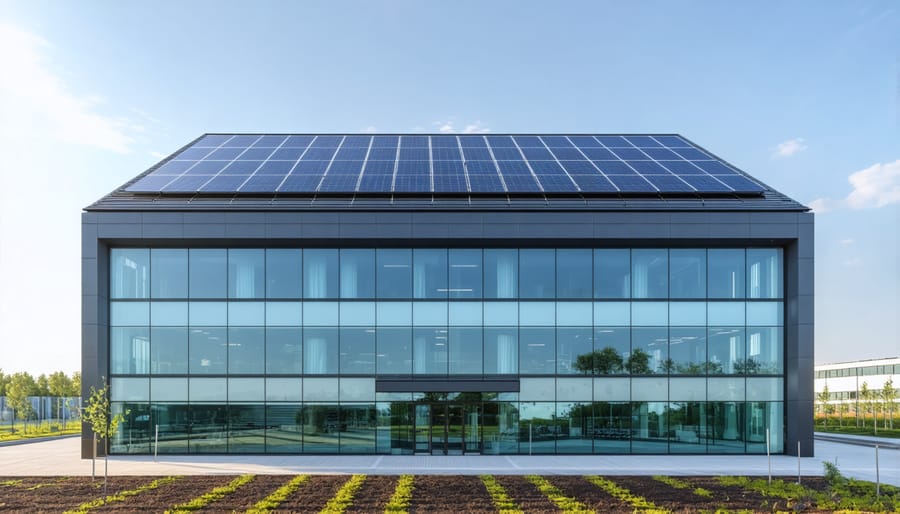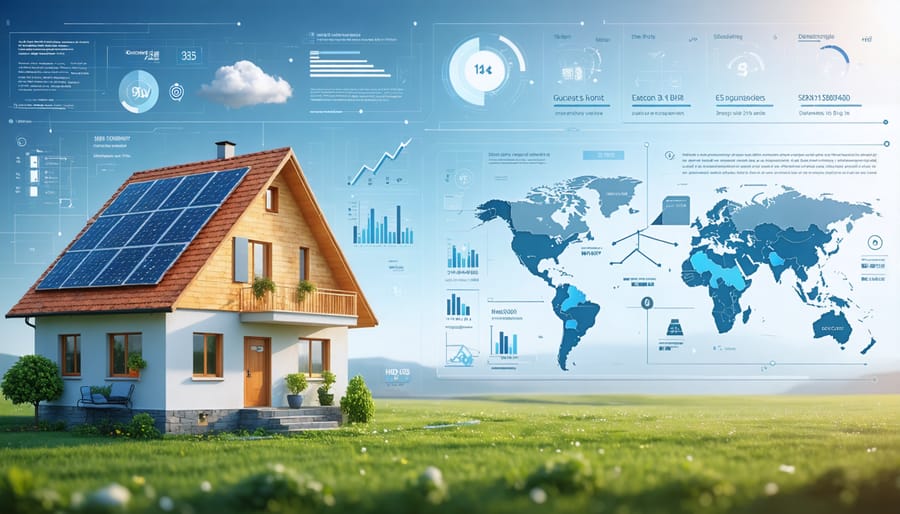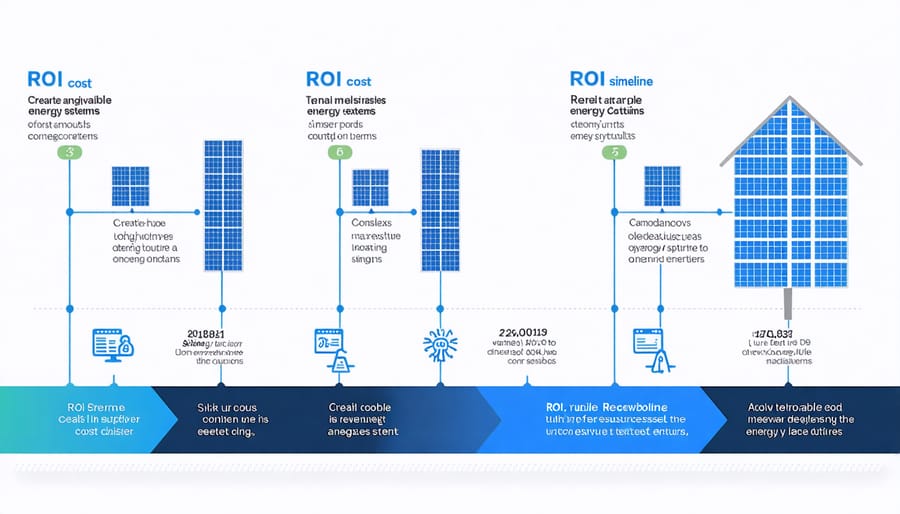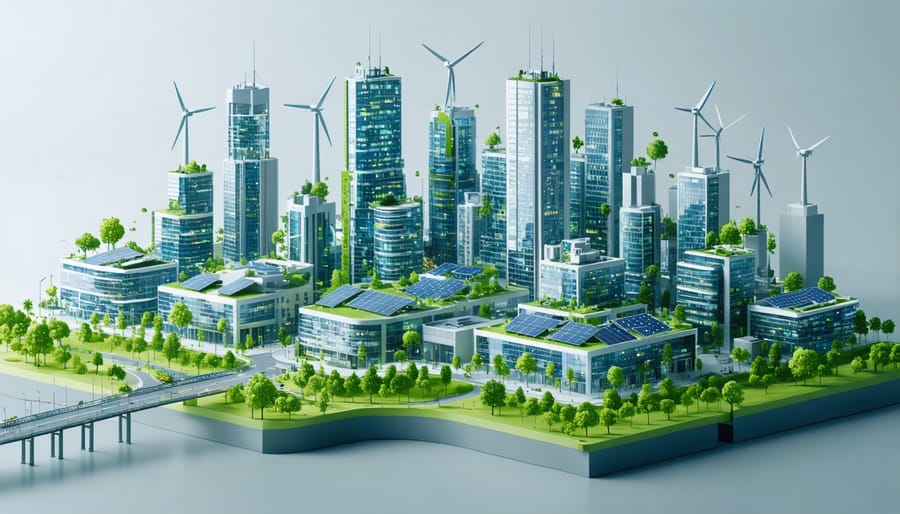The integration of renewable energy sources has emerged as a transformative force reshaping modern construction and infrastructure development. As global energy demands surge and environmental concerns intensify, the strategic incorporation of renewable technologies into building systems represents not just an environmental imperative, but a compelling economic opportunity. Industry leaders are rapidly embracing what experts now recognize as the future of renewable architecture, driving innovation across solar, wind, and geothermal applications. Recent data indicates that buildings implementing integrated renewable systems achieve 40-60% reduction in operational costs while meeting stringent sustainability requirements. This shift demands a sophisticated understanding of system integration, grid connectivity, and energy storage solutions—critical knowledge for construction professionals navigating the evolving landscape of sustainable development. As regulatory frameworks evolve and technology costs decline, the ability to effectively integrate renewable energy sources has become a defining factor in project success and long-term building performance.
Current State of Renewable Integration in Construction
Popular Renewable Technologies in Construction
In modern construction, three primary renewable technologies have emerged as industry standards. Solar photovoltaic (PV) systems lead the way, with both rooftop installations and building-integrated photovoltaics (BIPV) offering versatile solutions for energy generation. These systems can be seamlessly incorporated into building facades, windows, and roofing materials, providing both functionality and aesthetic value.
Wind energy integration, while less common in urban settings, has gained traction through innovative micro-wind turbines designed specifically for buildings. These systems are particularly effective in high-rise structures and areas with consistent wind patterns, offering supplementary power generation capabilities.
Geothermal energy systems represent another crucial technology, utilizing ground-source heat pumps to provide efficient heating and cooling. These systems leverage stable underground temperatures to maintain comfortable building conditions while significantly reducing energy consumption.
Each of these technologies can be implemented individually or as part of an integrated renewable energy strategy, depending on site conditions, building requirements, and project objectives. The key to successful implementation lies in careful planning during the early design phases and proper system sizing based on building load calculations.
Integration Challenges and Solutions
The integration of renewable energy sources presents several significant challenges that require innovative solutions. Grid stability remains a primary concern, as fluctuating power generation from solar and wind sources can create voltage irregularities. To address this, advanced power electronics and smart grid technologies are being deployed, including sophisticated inverters with grid-support functions and battery storage systems that help smooth out supply variations.
Intermittency issues are being tackled through hybrid systems that combine multiple renewable sources, supported by energy storage solutions. Modern battery management systems and thermal storage technologies enable better load matching and peak shaving capabilities. Additionally, predictive analytics and AI-driven forecasting tools are improving the accuracy of renewable energy production estimates, allowing for more efficient grid management.
Space constraints, particularly in urban environments, necessitate creative installation approaches. Building-integrated photovoltaics (BIPV) and vertical wind turbines are emerging as space-efficient solutions. Integration costs remain a challenge, but standardized connection protocols and modular system designs are helping reduce installation complexity and associated expenses. The development of microgrids and virtual power plants is also facilitating better integration of distributed energy resources into existing infrastructure.
Building-Integrated Renewable Systems

Solar Integration Solutions
Building-integrated photovoltaic (BIPV) systems represent a significant advancement in solar integration, seamlessly combining energy generation with architectural design. These systems replace conventional building materials in parts of the building envelope, such as roofs, skylights, or facades, while simultaneously producing electricity.
Modern solar tiles have revolutionized residential and commercial roofing solutions by offering aesthetically pleasing alternatives to traditional solar panels. These tiles mimic conventional roofing materials while incorporating photovoltaic cells, making them particularly attractive for historic buildings and design-sensitive projects. Recent technological improvements have increased their efficiency to nearly match that of standard solar panels, with some premium products achieving conversion rates of up to 20%.
Innovative integration methods extend beyond traditional applications. Solar facades can now incorporate semi-transparent photovoltaic glass, enabling natural light penetration while generating power. Advanced mounting systems allow for solar panel integration at various angles and orientations, maximizing energy capture in challenging architectural contexts.
Smart design solutions include solar shading devices that serve dual purposes: managing solar gain while generating electricity. These systems are particularly effective in commercial buildings, where cooling loads represent a significant energy demand. Integration with building management systems allows for real-time monitoring and optimization of energy production and consumption, ensuring maximum system efficiency.
The latest developments in solar integration technology focus on flexibility and customization, with manufacturers offering various sizes, shapes, and colors to meet specific architectural requirements while maintaining optimal performance standards.
Energy Storage and Smart Systems
Energy storage systems play a pivotal role in maximizing the effectiveness of renewable energy integration, with advanced battery technologies leading the transformation. Modern lithium-ion battery installations, coupled with smart energy management solutions, enable buildings to store excess power during peak production periods and utilize it during high-demand times or low generation periods.
Commercial-scale battery systems typically incorporate multiple storage units, advanced inverters, and sophisticated monitoring equipment. These systems can be scaled from small commercial buildings to large industrial complexes, with storage capacities ranging from 50kWh to several MWh. The integration of artificial intelligence and machine learning algorithms optimizes charging and discharging cycles, significantly improving system efficiency and extending battery life.
Recent developments in flow batteries and solid-state technology are expanding storage options, offering longer operational lifespans and improved safety profiles. These innovations are particularly valuable for construction projects in extreme climate conditions or where space constraints exist.
Building management systems (BMS) interface directly with storage solutions, enabling real-time load balancing and demand response capabilities. This integration allows facilities to participate in grid services, potentially generating additional revenue streams while supporting grid stability. The combination of precise energy monitoring, predictive analytics, and automated control systems ensures optimal energy utilization while maintaining occupant comfort and operational efficiency.

Cost-Benefit Analysis
Initial Investment vs Long-term Returns
The initial investment in renewable energy systems often presents a significant upfront cost, ranging from $15,000 to $25,000 for residential solar installations and substantially more for commercial implementations. However, comprehensive analysis reveals that these systems typically achieve long-term cost savings that justify the initial expenditure. Solar installations, for instance, demonstrate an average payback period of 5-7 years in most regions, with system lifespans extending beyond 25 years.
Wind energy systems show similar investment patterns, with utility-scale installations averaging $1.3-1.8 million per megawatt of capacity installed. Commercial building implementations typically recover costs within 8-10 years through reduced energy expenses and government incentives. Geothermal systems, while requiring higher initial investments of $20,000-$25,000 for commercial applications, deliver consistent returns through 30-50% reductions in heating and cooling costs.
Recent case studies indicate that integrated renewable systems combining multiple technologies can accelerate ROI timeframes by 15-20%. When factoring in current federal tax incentives, state rebates, and increasing utility costs, most commercial installations achieve positive returns within the first decade of operation, while continuing to generate value for decades thereafter.

Government Incentives and Regulations
Government incentives and regulatory frameworks play a crucial role in accelerating renewable energy integration within construction projects. The Investment Tax Credit (ITC) offers up to 30% tax credit for solar installations, while the Production Tax Credit (PTC) provides significant benefits for wind energy projects. Many states have implemented additional incentives, including grants, rebates, and performance-based incentives that can substantially reduce initial investment costs.
Building codes and regulations increasingly mandate renewable energy integration, particularly in new construction. For instance, California’s Title 24 requires solar installations on most new residential buildings, setting a precedent for other states. The International Energy Conservation Code (IECC) and ASHRAE standards provide comprehensive guidelines for energy efficiency and renewable integration that many jurisdictions have adopted.
Property Assessed Clean Energy (PACE) financing programs enable building owners to fund renewable energy installations through property tax assessments, while net metering policies allow excess generated power to be sold back to the grid. Federal agencies also offer various grant programs and loan guarantees specifically designed for commercial and industrial renewable energy projects.
Compliance with these regulations requires careful planning and documentation, but the available incentives can significantly improve project ROI and accelerate adoption of renewable technologies.
Case Studies and Success Stories
Commercial Projects
Commercial buildings have emerged as significant showcases for successful renewable energy integration, demonstrating both environmental stewardship and financial viability. The Bullitt Center in Seattle stands as a prime example, achieving net-zero energy status through a comprehensive solar array system and ground-source heat pumps. This six-story commercial building generates 60% more energy than it consumes annually, proving that aggressive sustainability goals are achievable in urban settings.
Another noteworthy implementation is the Edge building in Amsterdam, which has earned recognition as one of the world’s most sustainable office buildings. Its success lies in the strategic combination of solar panels, rainwater harvesting, and an aquifer thermal energy storage system that maintains optimal temperature year-round while minimizing energy consumption.
The Tower at PNC Plaza in Pittsburgh demonstrates how renewable energy can be integrated into traditional corporate architecture. Its solar chimney and double-skin facade work in tandem with a geothermal well field, reducing energy consumption by 50% compared to conventional office buildings. The project’s success has inspired similar implementations across the corporate sector.
Recent data indicates that commercial buildings incorporating renewable energy systems see an average 30-40% reduction in operational costs within the first five years. The initial investment, while significant, typically yields returns within 7-10 years through reduced utility expenses and increased property value. Furthermore, these buildings consistently achieve higher occupancy rates and command premium leasing prices, offering compelling evidence for the business case of renewable energy integration in commercial construction.
Residential Developments
Recent residential developments showcase innovative approaches to integrating renewable energy systems, demonstrating both environmental consciousness and economic viability. The Drake Landing Solar Community in Alberta, Canada, stands as a pioneering example, featuring 52 homes powered by a district heating system that utilizes solar thermal collectors and seasonal thermal storage, achieving over 90% solar heating fraction annually.
In California, the KB Home ProjeKt incorporates a comprehensive renewable energy package, combining high-efficiency solar panels with smart energy management systems. The development’s homes feature integrated battery storage solutions, enabling residents to optimize their energy consumption patterns and reduce grid dependency.
The Solarsiedlung (Solar Settlement) in Freiburg, Germany, represents another successful implementation, where 59 homes achieve plus-energy status through strategic photovoltaic integration and passive solar design principles. Each residence generates more energy than it consumes annually, feeding excess power back into the grid.
In Australia, the Sustainable Buildings Research Centre demonstrates residential integration possibilities through its Living Building Challenge certification. The facility incorporates building-integrated photovoltaics (BIPV), solar thermal systems, and advanced energy monitoring capabilities, serving as a research hub and demonstration site for future residential applications.
These developments highlight key success factors: careful system sizing, integration with building design from the planning phase, and sophisticated energy management technologies. Notable features include smart inverters, home energy management systems (HEMS), and weather-responsive controls that optimize renewable energy utilization while maintaining occupant comfort and system efficiency.
The integration of renewable energy sources into construction projects has emerged as a cornerstone of sustainable building practices, transforming how we approach energy management in the built environment. Throughout this exploration, we’ve seen how solar, wind, and other renewable technologies are revolutionizing construction methodology and operational efficiency.
The economic benefits of renewable integration have become increasingly apparent, with documented reductions in operational costs and enhanced property values. Case studies from leading construction projects worldwide demonstrate that initial investments in renewable systems typically achieve ROI within 5-10 years, while providing long-term energy security and independence.
Looking ahead, the construction industry is poised for even greater adoption of renewable technologies. Emerging trends point toward more sophisticated energy storage solutions, improved solar efficiency, and advanced building management systems that optimize renewable energy utilization. The development of smart grid technologies and virtual power plants will further enhance the integration capabilities of renewable systems in construction projects.
However, successful implementation still requires careful planning, technical expertise, and collaboration among stakeholders. Construction professionals must stay informed about evolving regulations, technological advancements, and best practices in renewable integration. The future of construction inevitably leads toward net-zero buildings and carbon-neutral developments, making renewable energy integration not just an option, but a necessity.
As we move forward, the focus will increasingly shift toward holistic energy solutions that combine multiple renewable sources, enhanced storage capabilities, and intelligent distribution systems. This integration will continue to reshape construction practices, driving innovation and sustainability in the built environment for generations to come.

